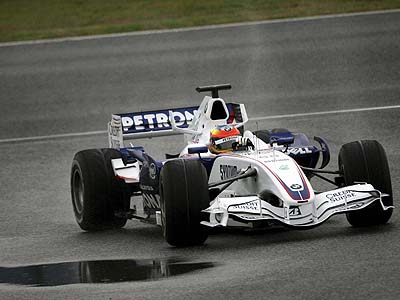


09/02/2007
NEWS STORY
 |
Bridgestone Motorsport completed a three day test on Thursday 8 February at the Circuito de Jerez. This test was an opportunity for teams to gain further knowledge of the medium compound dry grooved tyre Bridgestone has produced for 2007.
The final day of the test, Thursday, was wet which allowed teams to run with the wet and extreme wet weather tyres.
As agreed by the Testing Committee three further three-day group tests will be conducted in February. The official dates for the tests are 12-14 February at the Circuit de Catalunya in Spain and two consecutive tests at the Bahrain International Circuit from 22-24 February and 27 February to 1 March.
Q&A with Kees van de Grint, Bridgestone Motorsport Head of Track Engineering Operations:
Are the new specification tyres of a harder compound than last season? How does this affect the teams and drivers?
Kees van de Grint: A target of the development of the new compounds is to make the tyre easier to drive. We have changed the working range of the tyre to make the temperature range in which the tyre operates wider. The overall grip level is lower, but the temperature dependency of the grip is far wider and not so extreme, which means improved driveability.
What does the wider operating window of the 2007 specification mean for teams and drivers?
KvdG: We believe it is easier to drive and this has been seen in the testing we have had where the teams have been able to go out when it is not much above 0° Celsius and then up to 25° Celsius with the same tyre. Warm up has become less of an issue. Over the course of a season there is a lot of variation of temperature and of track surface and the wider operating window we have accounts for this. We have tested at different circuits and on different types of tarmac and have had good feedback from all of them.
Can you clarify how the decision is made for which two tyre compounds are taken to each Grand Prix?
KvdG: We already have a plan of our expected tyre compound allocation for the season which is based on our estimates of wear life, graining level, and the blister level of the compounds. Whilst the outline allocation is decided, we are still conducting the winter tests which give us validation of our estimates and after these are completed we will make our final decisions. So far though we are happy and confident with what we have seen related to our estimates.
What were the aims of this week’s test and which tyres were tested at Jerez?
KvdG: We used the medium, wet and extreme wets here. This is our third winter test at Jerez so we have already confirmed that the tyre works well in these conditions. It is more of an opportunity for the teams to get further data and become more confident with their chassis. There has been some tyre degradation of course, but at the moment the teams are still studying how to run with the new tyres and how to make the best use of their characteristics. Of course the difference this year is that it is the teams who have to adapt to the tyres whereas in previous years we have provided teams with tyres to suit each of them and each circuit.
The final day at Jerez featured a wet circuit, which tyres were used on this and what did you learn?
KvdG: On Thursday we ran with the wet and extreme wet weather tyres. The operating window of both tyres was very similar to our expectations, their performance has been good and they provide a good base for teams to work with when they face variable conditions.
How do you expect hot weather to affect the different compounds?
KvdG: The only aspect we need to validate is our estimation of how the tyres will work in hot conditions as we have not had hot weather so far in testing. Hopefully it will be hot in Bahrain, judging from our experience last year we gained valuable data when we visited there. It could be that the Sepang test is the first time teams run in really hot conditions, and we will be very interested in those results. The main concern from the heat is tyre degradation, but the compounds we have selected are the best from the information we have so far, and we can expect improvements in car development and setup as teams learn more about their cars.
Are there differences in the data coming back from the teams?
KvdG: There are, of course, differences as the teams are running with different cars. The general trends are similar however.
Which compounds are scheduled for the next tests in Barcelona and Bahrain?
KvdG: In Barcelona we will be using the hard compound and in Bahrain we will use the medium and hard compounds.
To check out our Jerez Test gallery, click here
To check out our 2007 test centre, click here